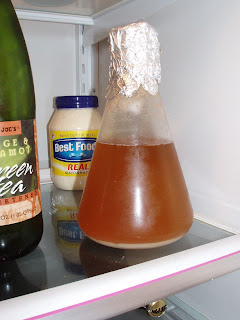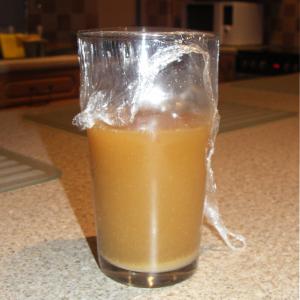has to do with the actual pitch rates of the smack packs and tubes, and has to do with the data that Jamil Z has on his mr malty website.
I'll quote some of it, but really you should look at the stuff there;
http://www.mrmalty.com/pitching.php
Ales & Lagers
The general consensus on pitching rates is that you want to pitch around 1 million cells of viable yeast, for every milliliter of wort, for every degree plato. A little less for an ale, a little more for a lager. George Fix states about 1.5 million for a lager and 0.75 million for an ale in his book, An Analysis of Brewing Techniques. Other literature cites a slightly higher amount. I'm going with Fix's numbers and that is what the pitching calculator uses.
The Math
If you're curious, here is the simple math to calculate the number of cells needed. For an ale, you want to pitch around 0.75 million cells of viable yeast (0.75 million for an ale, 1.5 million for a lager), for every milliliter of wort, for every degree plato.
(0.75 million) X (milliliters of wort) X (degrees Plato of the wort)
* There is about 3785 milliliters in a gallon. There are about 20,000 milliliters in 5.25 gallons.
* A degree Plato is about 1.004 of original gravity. Just divide the OG by 4 to get Plato (e.g., 1.048 is 12 degrees Plato).
So, for a 1.048 wort pitching into 5.25 gallons you need about 180 billion cells.
(750,000) X (20,000) X (12) = 180,000,000,000
As an easy to remember rough estimate, you need about 15 billion cells for each degree Plato or about 4 billion cells for each point of OG when pitching into a little over 5 gallons of wort. If you want a quick way of doing a back of the envelope estimate, that is really close to 0.75 billion cells for each point of gravity per gallon of wort. Double that to 1.5 billion for a lager.
Pitching From Tubes, Packs, or Dry Yeast
Both White Labs and Wyeast make fantastic products and you can't go wrong with either one. There are differences between their strains and each brand has pluses and minuses yet neither is better than the other across the board. Use the brand your local homebrew shop carries, if you need a way to decide.
A White Labs tube has between 70 and 120 billion cells of 100% viable yeast, depending on the yeast strain. Some cells are much larger than others and there are more or less per ml based on size. (The information on the White Labs web site stating 30 to 50 billion cells is out of date.) We can just assume there are around 100 billion very healthy yeast. You would need 2 tubes if you were pitching directly into 5.5 gallons of 1.048 wort to get the proper cell counts.
A Wyeast Activator pack (the really big ones) and the pitchable tubes have an average of 100 billion cells of 100% viable yeast. The smaller packs are around 15-18 billion cells. You would need 2 of the large packs if you were pitching directly into 5.5 gallons of 1.048 wort to get the proper cell counts. For the small packs, you'd need eleven of them!
But to make it easier he has a great pitch rate calculator
http://www.mrmalty.com/calc/calc.html
And according to his numbers on his calculator, really any beer above 1.020, you should be making a starter for.
Me personally when I use liquid yeast I just make a starter. I may not be as anal as some brewers and makes sure that I have the exact cellcount for whatever gravity beer I am making, but I do make one for the above reasons I mentioned, namely peace of mid, and a reduction in lag time.
Seriously, that's one way to insure you have clean tasting beer, not to stress out or underpitch your yeast. You may find the "bothering" to make a starter will make even the less than best kit beer come out tasting great.
How to make one;
What you need to create a simple starter:
•Extra light DME (3-4oz)
•1 quart water
•4-6 quart sauce pan with lid
•Pyrex flask or masn jar, or any container
•Tin foil
•Room temperature liquid yeast or dry yeast that has been re hydrated in 95F-105F water
The process:
•Bring 1 quart of water to a boil in the sauce pan.
•Measure 3-4 oz of DME and introduce this to the boiling water, stir well, boil 10 minutes.
•Remove from heat, placing lid on the sauce pan.
•Cool the starter wort in a shallow, cold water bath or in the refrigerator until it reaches the target fermentation temperature of the beer you will brew with it.
•Once cool, pour the starter wort into a sanitized flask or carboy.
•Secure a piece of tin foil on the opening of the flask or carboy and shake vigorously to aerate the wort.
•Pitch the yeast (add yeast into the flask / carboy containing the aerated wort).
•Seal container with a clean piece of foil, or a cork fitted with an air lock.





